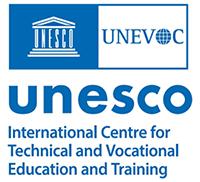
The UNESCO-UNEVOC International Centre: Who We Are | What We Do | Working With Us | Get in Touch
The UNEVOC Network: Learn About the Network | UNEVOC Network Directory
For Members: UNEVOC Centre Dashboard
Thematic Areas: Inclusion and Youth | Digital Transformation | Private Sector Engagement | SDGs and Greening TVET
Our Key Programmes & Projects: BILT: Bridging Innovation and Learning in TVET | Building TVET resilience | TVET Leadership Programme | WYSD: World Youth Skills Day
Past Activities: COVID-19 response | i-hubs project | TVET Global Forums | Virtual Conferences | YEM Knowledge Portal
Our Services & Resources: Publications | TVET Forum | TVET Country Profiles | TVETipedia Glossary | Innovative and Promising Practices | Toolkits for TVET Providers | Entrepreneurial Learning Guide
Events: Major TVET Events | UNEVOC Network News
Also known as e-learning or online learning, it is a form of education in which teachers and students are physically separated. Various technologies such as Skype allow for teachers and students to interact and communicate. Traditional distance learning focused on individuals in remote areas and it used to be via mail.
The learner has been matched with a teacher, tutor, or volunteer with whom he/she has regular interaction with regard to the content of the distance learning curriculum, and who provides support throughout the distance learning experience. Distance learning is characterized by all of the following:
Education and training imparted at a distance through communication media: books, radio, TV, telephone, correspondence, computer or video.
 Source:
Source: National Research and Development Centre for adult literacy and numeracy (commissioned by the EU), European Adult Learning Glossary level 1, 2011
National Research and Development Centre for adult literacy and numeracy (commissioned by the EU), European Adult Learning Glossary level 1, 2011
Instructional model in which the teacher or trainer and the learner are physically separated and use various resources and technologies to interact, simultaneously or not.
Comment
Distance learning may combine e-learning, online learning, virtual learning, books, audio, video and correspondence courses;
 Source:
Source: Cedefop, Glossary. Terminology of European education and training policy, (accessed 03/2023)
Cedefop, Glossary. Terminology of European education and training policy, (accessed 03/2023)